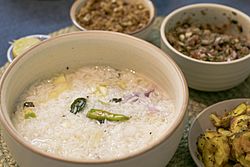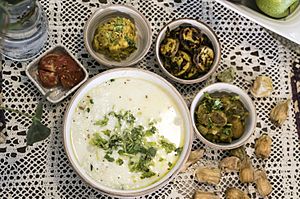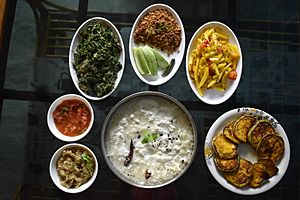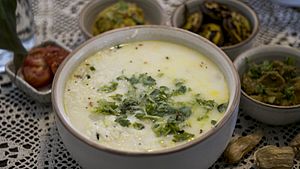Pakhala facts for kids
 |
|
| Course | Saja Pakhaḷa (fresh rice), Basi Pakhala (stale rice), Jira Pakhala (cumin rice), Dahi Pakhala (curd rice) |
|---|---|
| Place of origin | Indian subcontinent |
| Region or state | Odisha |
| Associated national cuisine | Odia cuisine |
| Serving temperature | Hot and cold |
| Main ingredients | Cooked rice |
| Variations | Panta bhat |
Pakhaḷa (Odia: ପଖାଳ Pakhāḷa) is a popular dish from Odisha, India. It is made from cooked rice that is either washed or lightly fermented in water. The watery part of this dish is called Toraṇi (Odia: ତୋରାଣି ṭorāṇi).
Pakhaḷa is very popular in Odisha. You can also find similar versions in other eastern parts of India. These areas include Jharkhand, Chhattisgarh, Bengal, Assam, and Tripura.
People often eat this refreshing dish during the hot summer months. However, many enjoy it all year round, especially for lunch. It helps keep you cool and provides important nutrients. A traditional Pakhaḷa includes rice, curd (yogurt), cucumber, cumin seeds, fried onions, and mint leaves. It is often served with roasted vegetables like potato or brinjal. You can also have it with fried badi (lentil dumplings), saga bhaja (fried leafy greens), or fried fish.
Contents
What is Pakhala?
The name "pakhala" comes from old words. It comes from the Pali word "pakhāḷitā" and the Sanskrit word "Prakshāḷaṇa." Both of these words mean "washed" or "to wash." This makes sense because the rice is washed in water.
A Taste of History
We don't know exactly when Pakhaḷa first became a daily meal in Eastern India. But it was part of the recipes for Lord Jagannath Temple in Puri around the 10th century. This suggests that Pakhaḷa might have first appeared in Odisha.
There's even a special day for Pakhaḷa! Every year, on March 20th, people in Odisha celebrate Pakhala Dibasa. This day is a way for all Odia people to celebrate their favorite dish. The word pakhaḷa was also used in Odia poems. A writer named Arjuna Das mentioned it in his work Kaḷpalata between 1520 and 1530 AD. This shows how old and important this dish is.
Different Kinds of Pakhala
There are several ways to prepare Pakhaḷa. Here are some of the most popular types:
Popular Pakhala Styles
- Saja Pakhaḷa (fresh pakhaḷa): This is made by adding water to freshly cooked rice right away. A few drops of lemon are often added. This type does not need to be fermented.
- Basi Pakhaḷa (stale pakhala): The word basi in Odia means "stale." This version is made by letting cooked rice ferment in water overnight. It is then eaten the next day. This is the traditional way to make Pakhaḷa. People often eat it with badi chura (crushed lentil dumplings), diced onions, and lemon for extra flavor.
- Jira Pakhaḷa: This type gets its name from jira, which means cumin. It is made by adding fried cumin seeds and curry leaves to the Pakhaḷa.
- Dahi Pakhaḷa: Dahi means curd or yogurt. This Pakhaḷa is made by adding curd to the rice and water mixture. Badi chura is a common side dish with Dahi Pakhaḷa.
Other Pakhala Variations
- Garama Pakhala: This is similar to Saja Pakhaḷa but is served with hot rice instead of cool rice.
- Paani Pakhala: This is a simple version made by just adding salt and water to cooked rice.
- Ada Pakhala: Ada means ginger. This Pakhaḷa has ginger and salt added to the cooked rice soaked in water.
- Sugandhi Pakhala or Subasa Pakhala: These names mean "flavored pakhala." It's made by adding chopped ginger and roasted cumin seeds to the rice in salty water. This gives the dish a lovely smell.
- Chupuda Pakhala: This means "squeezed pakhala." The cooked rice is squeezed to remove excess water. It is then served with curd, roasted cumin, and salt.
- Mitha Pakhala: Mitha means sweet. This is an unusual type where sugar or jaggery is added to the rice and water, along with roasted cumin. Sometimes oranges are also added. It's not as common as the fresh or stale versions.
- Tabhaa Pakhala: This version is made by adding lemon water to the cooked rice.
- Ghia Pakhala: Ghia means ghee (clarified butter). Ghee is added to the cooked rice for a rich flavor.
- Malliphula Pakhala: Malli phula means jasmine flower. Jasmine flowers are added to the cooked rice for a fragrant aroma.
How to Make Pakhala
Making Pakhaḷa is quite simple! First, cook your rice and let it cool down. Then, put the cooled rice in a bowl and add water.
For extra flavor, you can make a chhunka or tadka. Heat a little oil in a pan. Add mustard seeds, curry leaves, and dry red chili. Fry them until they smell good. Pour this mixture into the Pakhaḷa bowl. You can also add sour curd, mint leaves, and raw salt to make it taste even better.
Many people enjoy Pakhaḷa with different side dishes. These can include fried fish, sukhua poda (fried dried fish), saga bhaja (fried leafy greens), or badi chura. Badi chura is made from fried lentil dumplings that are crushed. Sometimes, cumin seeds are fried, ground into a powder, and mixed with curd, coriander leaves, and salt. It's also often served with a fish fry and spinach.
Traditional Pakhala Making
Traditionally, Basi Pakhaḷa is slightly fermented rice. You cook the rice, add water, and sometimes a little bit of old Pakhaḷa to help it ferment. The best flavor comes after 8 to 12 hours. If you let it sit for this long, you don't need to add old Pakhaḷa, as it will ferment naturally. The Pakhaḷa itself tastes a bit sour. Some people add a paste of green chili, green mango, and ginger for a hot and sweet taste.
Common side dishes include roasted or boiled potato (aloo poda), fried vegetables, or fried fish. Other popular sides are dahi baigana (yogurt eggplant), kakharu phula bhaja (fried pumpkin flowers), mashed potatoes (alu bharata), fried prawns (chingudi bhaja), and sukhua (dried fish).
Pakhala Day!
To make Pakhaḷa even more famous, people started celebrating Pakhala Dibasa (Pakhala Day). This special day was first celebrated on March 20, 2011. Now, every year on March 20th, Odias all over the world celebrate this day. They eat Pakhaḷa and help promote this wonderful dish.
Pakhala Around India
Pakhaḷa has many names and versions in other parts of India:
- Chhattisgarh: bore bhat
- Jharkhand: paani bhat
- Gujarat: Ghesh Bhat
- Tamil Nadu: pazhedhu saadham
- Andhra Pradesh: saddi annam
- Bengal: panta bhat
- Assam: poita bhat
- Kerala: Pazham Kanji
See also
 In Spanish: Pakhal para niños
In Spanish: Pakhal para niños





